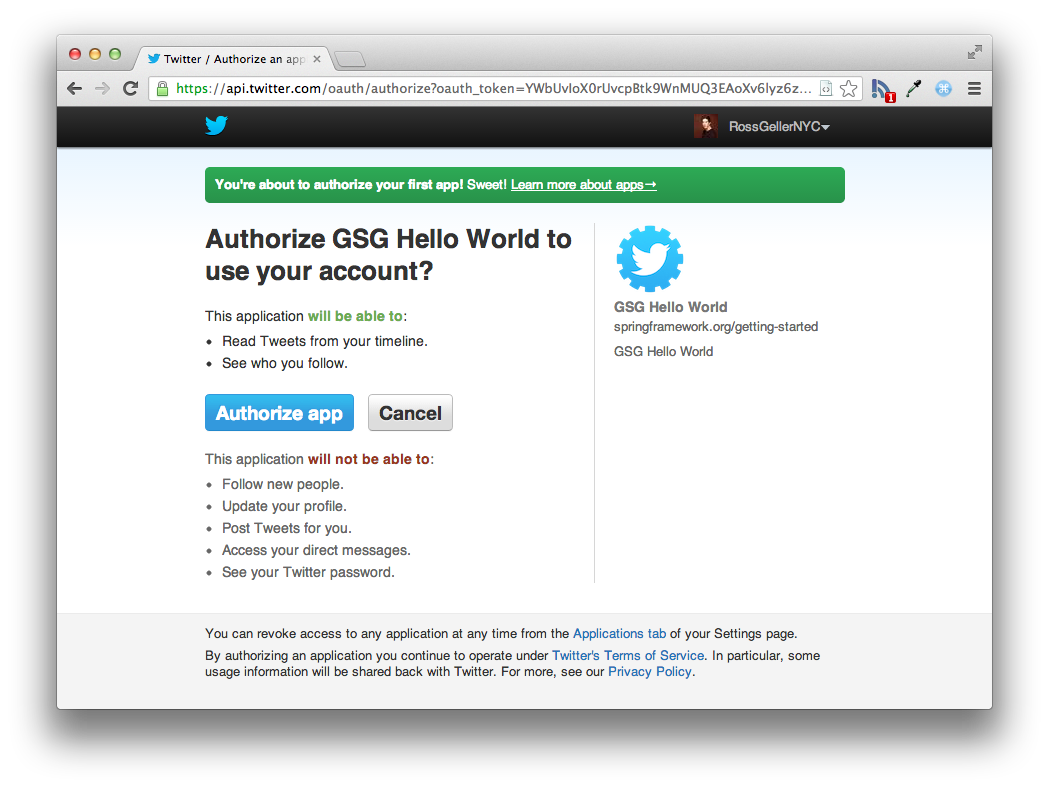| tags | projects | |
|---|---|---|
|
This guide walks you through the process of creating a simple web application that fetches data from Twitter.
You’ll learn how to build a Spring application that accesses profile data from a Twitter user and from people whom the user follows on Twitter.
+ - An application ID and secret obtained from registering an application with Twitter.
Before you can fetch a user’s data from Twitter, you must specify your application’s ID and secret by setting the spring.social.twitter.appId and spring.social.twitter.appSecret properties. You can set these via any means supported by Spring Boot, including setting them in an application.properties file:
src/main/resources/application.properties
link:complete/src/main/resources/application.properties[role=include]As shown here, the properties have fake values. The values given to these properties correspond to your application’s consumer key and secret you obtain when you register the application with Twitter. For the code to work, substitute the real values given to you by Twitter in place of the fake values. The appId is Twitter’s "Consumer Key", and the appSecret is teh "Consumer Secret". Be sure to register a callback URL with Twitter (it has to be a valid URL, but it doesn’t need to be the URL of your app).
The presence of these properties and Spring Social Twitter in the classpath will trigger automatic configuration of Spring Social’s ConnectController, TwitterConnectionFactory, and other components of Spring Social’s connection framework.
Although much of what ConnectController does involves redirecting to Twitter and handling a redirect from Twitter, it also shows connection status when a GET request to /connect is made. ConnectController defers to a view named connect/{provider ID}Connect when no existing connection is available and to connect/{providerId}Connected when a connection exists for the provider. In this case, {provider ID} is "twitter".
ConnectController does not define its own connection views, so you need to create them. First, here’s a Thymeleaf view to be shown when no connection to Twitter exists:
src/main/resources/templates/connect/twitterConnect.html
link:complete/src/main/resources/templates/connect/twitterConnect.html[role=include]The form on this view will POST to /connect/twitter, which is handled by ConnectController and will kick off the OAuth authorization code flow.
Here’s the view to be displayed when a connection exists:
src/main/resources/templates/connect/twitterConnected.html
link:complete/src/main/resources/templates/connect/twitterConnected.html[role=include]With Twitter configured in your application, you now can write a Spring MVC controller that fetches data for the user who authorized the application and presents it in the browser. HelloController is just such a controller:
src/main/java/hello/HelloController.java
link:complete/src/main/java/hello/HelloController.java[role=include]HelloController is created by injecting a Twitter object into its constructor. The Twitter object is a reference to Spring Social’s Twitter API binding.
The helloTwitter() method is annotated with @RequestMapping to indicate that it should handle GET requests for the root path (/). The first thing it does is check to see if the user has authorized the application to access the user’s Twitter data. If not, then the user is redirected to ConnectController with the option to begin the authorization process.
If the user authorizes the application to access the data, the application can fetch almost any data pertaining to the authorizing user. For the purposes of this guide, the application only fetches the user’s profile as well as a list of profiles belonging to Twitter users whom the user follows (but not those who follow the user). Both are placed into the model to be displayed by the view identified as "hello".
Speaking of the "hello" view, here it is as a Thymeleaf template:
src/main/resources/templates/hello.html
link:complete/src/main/resources/templates/hello.html[role=include]This template simply displays a greeting to the user and a list of the user’s friends. Note that even though the full user profiles were fetched, only the names from those profiles are used in this template.
Although it is possible to package this service as a traditional WAR file for deployment to an external application server, the simpler approach demonstrated below creates a standalone application. You package everything in a single, executable JAR file, driven by a good old Java main() method. And along the way, you use Spring’s support for embedding the Tomcat servlet container as the HTTP runtime, instead of deploying to an external instance.
src/main/java/hello/Application.java
link:complete/src/main/java/hello/Application.java[role=include]... app starts up ...
Once the application starts up, you can point your web browser to http://localhost:8080. Because no connection is established yet, you see this screen prompting you to connect with Twitter:
When you click Connect to Twitter, the browser is redircted to Twitter for authorization:
At this point, Twitter asks if you’d like to allow the sample application to read tweets from your profile and see who you follow. Here the screen is misleading, because the application in this case will only read your profile details and the profile details of the people you follow. Click Authorize app to grant permission.
Once permission is granted, Twitter redirects the browser to the application. A connection is created and stored in the connection repository. You should see this page indicating that a connection was successful:
If you click on the link on the connection status page, you are taken to the home page. This time, now that a connection exists, you see your name on Twitter and a list of your friends:
Congratulations! You’ve developed a simple web application that uses Spring Social to obtain user authorization to fetch data from the user’s Twitter profile and from the profiles of people whom the user follows.



